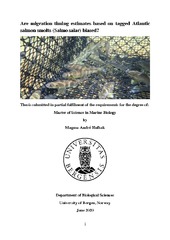Are migration timing estimates based on tagged Atlantic salmon smolts (Salmo salar) biased?
Master thesis

View/
Date
2020-06-20Metadata
Show full item recordCollections
- Master theses [269]
Abstract
Telemetry tags (e.g. PIT- or acoustic tags) are increasingly used in management to monitor the migration timing of Atlantic salmon smolts (Salmo salar). Recent findings, however, suggest that tagged fish consistently migrate earlier than untagged counterparts based on monitoring with other methods (e.g. trap-nets and video surveillance). It has been postulated that (1) effects from tagging and handling may alter migration behaviour, and (2) that the selection of fish during sampling is not representative of all migrating smolts, yielding bias in migration timing estimates. In the river Dale (Norway), we tagged five groups of wild Atlantic salmon smolts (n=385) at different time points in April-May, recaptured them in a wolf trap, and compared the migration timing to the untagged population from respective tagging dates. Migration timing was not significantly different between tagged (12 mm HDX PIT-tag) and untagged fish. Smolts tagged shortly before initiation of migration showed the most similar migration timing to the untagged population. Migration timing was size-dependent, such that larger individuals migrated earlier than smaller ones. The probability of migration was positively correlated with length and decreased the later in the season smolts were tagged. The migration timing of fish caught in the wolf trap was positively affected by water temperature and discharge. This pattern was not revealed by applying the same model to the tagged fish in the same system, exemplifying the limitations of using telemetry tags to study the mechanism of migration. This study revealed that tagging studies need to be careful when designing, as well as interpreting, their results, particularly related to size-dependent migration behavior.